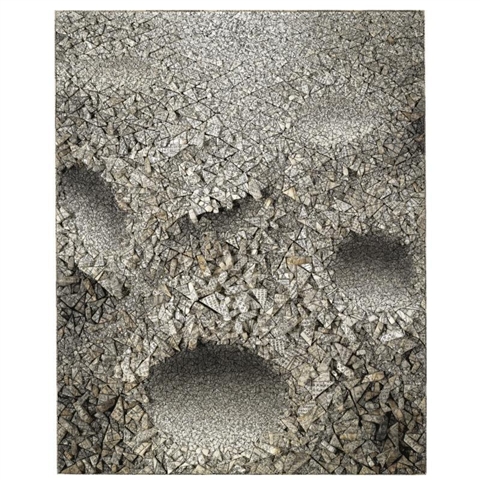Aggregation 04-ma023, ©Kwang Young Chun
This summer I’m taking a class called Hand Papermaking for Artists. It’s being taught by one of my favorite teachers at MSCD, Bonnie Ferrill Roman, who is also a fabulous artist. She uses handmade paper, branches, and other objects from nature in her sculpture work.
The class has been a lot of fun and very informative so far. In addition to hands-on experimentation with different ways of making and using paper (who knew there were so many!), the class also requires doing research on papermaking and artists who work in this media. I had to do a short research paper on an artist of my choice, and I chose Kwang-Young Chun. For several months, I have had a page with a large image of one his works torn from an issue of Artforum pinned up on my design wall. I’ve been looking at it for a long time because I find it fascinating, but now this research paper has provided a good impetus to find out more about his work and process.
Chun is a Korean artist who makes his work by wrapping small styrofoam triangles in mulberry paper taken from old books that he buys in large quantities and stores in an air-conditioned warehouse. After wrapping, each piece is tied with more paper that has been twisted into a narrow rope. Hundreds or thousands of these units are then combined into larger constructions, which might take the form of huge free-standing sculptures or low-relief wall pieces. See more of his work here, and a fabulous close-up detail here.
The areas that look like craters are created with trompe l’oeil effects rendered by varying the size and shading of the units in different areas of the piece. This is the kind of work that I find immensely satisfying. I love to imagine the endless hours and hours of patient, meditative process, wrapping and tying, and meticulous fitting of the thousands of pieces into a coherent, cohesive whole. The idea that someone would choose to spend his time in this way instead of sitting in front of a television or in a shopping mall gives me a great sense of hope and well being.


This is a wonderful post! I love Bonnie Ferrill Roman’s website – both the content and the way it is presented. I especially like some of the pieces in “illumination” and some in “small”. And Kwang-Young Chun – what can one say? The next time I’m grousing that what I do is too labor-intense, I’ll think of his work and that will calm me down, for sure! 🙂
First – a big huge congrats for taking the leap. You are a brilliantly talented artist and will go far. Great choice!
I love Kwang-Young Chun work – amazing, beautiful.
And now I can’t not ask. Can you comment on this post
https://deidreadams.com/how-long-did-that-take-you/
in relationship to your mention of time in this paper work? I am with you on being captivated by the thought of the work that went into these pieces and wonder if that type of questioning about our fiber work isn’t along the same lines.
Morna, glad you enjoyed the links!
Lisa, thanks for the huge compliment. Hope I can live up to it!
Regarding the use of one’s time and my earlier post, my thoughts go to visualizing this artist spending hours upon hours making the pieces and putting them together, being meditative, thoughtful, and fulfilled in the process of so doing. (As an aside, though, for all I know, he may have one or more assistants — some of these things are really huge, and I don’t know if it’s possible for one person to do this working alone.)
I think of the time as a fluid thing, perhaps more as a percentage of a day or a week, and not actual minutes tallied and recorded, quantified and distilled into numbers in a ledger.
If I were to ever meet him, I might be tempted to ask “How long did that take you?” only because it’s a knee-jerk reaction, and I might not be able to quickly think of anything more insightful to ask or say. I wouldn’t really want to hear an answer consisting of a certain number of hours or days, and would quickly forget it if I did.
What I would really want to know is, “What were you thinking about when you made this?” “Why do you do this, in this particular way?” “Do you ever get tired of doing this, and if so, what would you do instead?”
Is that what people are thinking when they ask about our work? I don’t really know, but I do find it interesting that you get the same question from both those who are genuinely interested and those who aren’t but feel they have to say something — anything at all — to fill the silence.